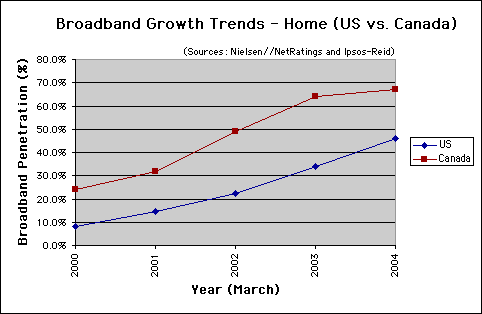Overall, broadband grew by 0.82 percentage points in March, with 45.97% of active Internet users enjoying a high-speed connection. 54.03% of US home users dial into the Internet with “narrowband” connections of 56Kbps or less. Canada’s broadband lead over the US shrank by 9.2%. While US broadband penetration grew by 12.2% over the past year, Canadian broadband penetration grew by just 3% from 64% to 67% over the same time period.
The charts below, derived from Nielsen//NetRatings and Ipsos-Reid data, show trends in connection speeds to the Internet for users in the United States and Canada.*
Home Connectivity in the US
As of March 2004, most users in the US connect to the Internet using dial-up modems of 56Kbps or less. 44.42% use 56Kbps modems, 6.88% use 28/33.3Kbps, and 2.73% use 14.4Kbps modems. In total. 54.03% of home users in the US connect to the Internet at 56Kbps or less (see Figure 1).
Web Connection Speed Trends – Home Users (US)
Figure 1: Web Connection Speed Trends – Home Users (US)
Source: Nielsen//NetRatings
Broadband Growth in the US
Broadband penetration in the US increased by 0.82 percentage points in March. As of March 2004 broadband penetration was at 45.97%, up from 45.15% in February. This is higher than the average increase in broadband of 0.76 percentage points per month from October 1999 to February 2004. Extrapolating the data provided by Nielsen//NetRatings, broadband share in the US should exceed 50% by July of 2004 (see Figure 2).
Broadband Connection Speed Trend – Home Users (US)
Figure 2: Broadband Connection Speed Trend – Home Users (US)
Extrapolated from Nielsen//NetRatings data
Work Connectivity
Most workers in the US enjoy high-speed connections to the Internet. Most use a high-speed line such as a T1 connection, and share bandwidth between computers connected to an Ethernet network. The speed of each connection decreases as more employees hook up to the LAN. As of March of 2004, of those connected to the Internet, 78.8% of US users at work enjoy a high-speed connection, up from 77.2% in February. 21.2% connect from work at 56Kbps or less (see Figure 3).
Web Connection Speed Trends – Work Users (US)
Figure 3: Web Connection Speed Trends – Work Users (US)
Source: Nielsen//NetRatings
US Narrows Broadband Gap with Canada
Over the past year, the US has narrowed the “broadband gap” with Canada by 9.2%. Since March 2003, US broadband penetration has grown by 12.2% from 33.8% to 46%, while Canadian broadband penetration has grown just 3%, from 64% to 67%. Canadian broadband penetration may be reaching a saturation point like Korea did when it reached 70% broadband penetration. Figure 4 compares the growth of broadband for US and Canadian home users.
Broadband Trends – Home Users (US vs. Canada)
Figure 4: Broadband Trends – Home (US vs. Canada)
Sources: Nielsen//NetRatings and Ipsos-Reid
Broadband Households as Percent of Internet Households
| By Country | 2000 | 2001 | 2002 | 2003 | 2004 |
|---|---|---|---|---|---|
| US | 8.1% | 14.5% | 22.3% | 33.8% | 46% |
| Canada | 24% | 32% | 49% | 64% | 67% |
Further Reading
- Canadian Broadband Continues Record Growth – US Broadband Penetration Slows – April 2003 Bandwidth Report
- As of March 2003, 64% of Canadian home users enjoyed a broadband connection.
- Internet surfers dumping dial-up for high speed
- Over 55% of Internet users in the US have access to broadband connections at work or at home, according to a survey by PEW Internet. Impatience was the major factor in the move to broadband. Nearly 6 out of 10 users cited slow web pages or slow file downloads as the main reason they switched from dial-up to broadband. According to PEW, 39% of adult Internet users have high-speed access at home, while 52% of college educated adults under 35 have broadband access at home. The use of DSL is surging in the US, with 42% of broadband users on DSL (up from 28% in March 2003) while 54% use cable (down from 67%). This move to DSL mirrors the trend we’ve seen in the rest of the world. Pew Internet & American
Life Project/USA Today, April 18, 2004 - Korean Broadband Penetration Breaks 70%, US Broadband Growth Lags
- Korean broadband breaks 70% for the first time in May of 2003 while US broadband was just over half that level of penetration at 35.87%.
- Survey: Denmark is Web-savviest nation
- Four Nordic countries are the Web-savviest nations in the world and, together with the United Kingdom, pushed the United States out of the top five, according to a survey by IBM and the intelligence unit of British magazine The Economist. News.com, April 19, 2004
*Note that Nielsen//NetRatings reports the percentage of active Internet users that use broadband from home, not broadband households. NetRatings uses a panel of 40,000 to 50,000 people with software meters installed on their computers. These meters detect connection speeds. Each month they do an enumeration study to call a number of people to calibrate the panel by adjusting weightings to match the population at large.
The Bandwidth Report is featured monthly on URLwire – news of useful and unique web content since 1994.




